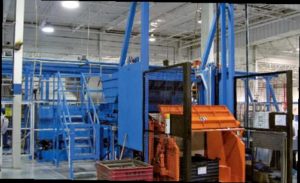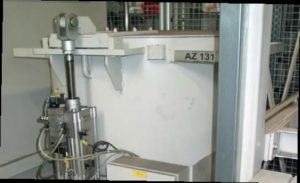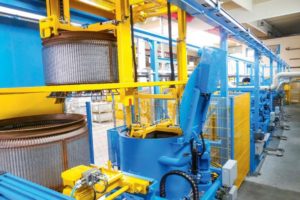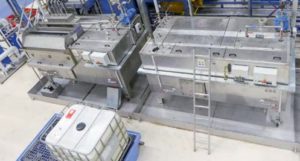
Bin or Container Dumper
Centrifugal parts washing systems typically include a bin or container dumper, automatic parts weighing system integrated with a loading system to load the centrifuge baskets or un a furnace belt after washing. Loading systems can discharge parts directly into the basket or incorporate devices to gently handle the parts during their transfer into the basket. After loading the parts they can be transferred through the process using a standard hoist or robot.

De-Oiling Spinner-Centrifuge
De-oiling parts prior to the washing process can recover oil, coolants and lubricants at rates up to 95%. In many cases these chemicals can be returned directly to the production process they were used for, or recovered and polished to meet the standards required in the previous process. De-oiling parts prior to washing also greatly reduces water consumption and chemicals. After the parts are de-oiled they are transferred to the aqueous parts washer. Please down the PDF on our stand alone centrifuge parts dryers and centrifuges.
Please download the PDF on our stand alone centrifuge parts dryers and centrifuges.

Aqueous Parts Washer
The basket of parts is lowered into the centrifugal industrial parts washer. The basket is then tilted on an angle of up to 60 degrees. The basket starts to rotate, and cleaning detergent is continuously fed into the basket which overflows to a collection tank below the washer. After the cleaning process the basket is returned to the vertical position and spun at a high RPM to centrifuge off the wash solution to reduce drag out. The movement of parts in the basket provides the additional benefit of mechanical cleaning to the chemical cleaning of the parts. The rate of rotation and tilt angle establishes the intensity of the mechanical portion of the cleaning process. For sensitive parts, process recipes with slow basket rotation and reduced tilt angles can be utilized to allow parts to gently roll over and around each other.
Heavily soiled non-sensitive parts that are washed or dephosphated are processed with higher basket rotation and tilt angles to aggressively clean them. The washing process is recipe driven to allow all parts to use unique parameters to optimize the cleaning process and productivity.

Parts Rinsing Centrifuge After Washing
After washing, the basket of parts is transferred to a rinsing module by a hoist. The rinsing process proceeds in the same way and with the same adjustment options as the washing process but with shorter treatment times. Most systems will have two rinses. Critical processes may require a third rinse. To reduce the use of fresh water and chemistry the rinses are counter flowed to provide make up solution the 1st rinse and wash solution tank After each rinse the basket is returned to the vertical position and spun at a high RPM to centrifuge off the rinse water and reduce drag out the rinse water and reduce drag out. Additional steps and components such as flushing and purging pipes or adding filters can be designed into the process to meet cleanliness specifications.

Centrifuge Parts Dryer
After rinsing, the basket of parts is transferred to a centrifuge dryer by a hoist. In most applications, the proven standard WMV AZ vertical drying centrifuge is used. If the parts are hollow, have recessed drives or are difficult to dry, an SZ tilting centrifuge dryer is recommended to reorient and circulate the parts. During drying, the advantage of the WMV centrifuge dryer comes into effect again. The heat energy absorbed during washing and rinsing provides enough heat to allow centrifugal force to dry the parts In the event additional energy is required to dry parts quickly and effectively providing energy savings. In the event additional energy is required to dry parts the machines are equipped with electric heaters, all of which are temperature controlled to minimize energy usage and preserve surface treatments.
Tilting dryers that reorient and circulate parts can be equipped with humidity monitoring. In this case, the heating capacity is regulated according to the measured humidity. If the humidity no longer changes the parts are dry and the centrifuge will return to the home position even if the recipe time has not been reached. Thus, only the necessary heating energy is used to dry the parts. Even when drying, care is taken to protect the parts. As a standard, the centrifugal dryers are equipped with variable speed control to avoid bending or damaging longer or more sensitive parts. In the case of tilting centrifuge dryers, the speed, tilt angle and the number of tilt cycles are adjustable.
The process parameters are tuned to the geometry of the part and used in process recipes that are assigned to a program or specific part.
Please download the PDF on our stand alone centrifuge parts dryers and centrifuges.

Transfer of Parts to Next Process or Container
After finishing the parts washing and drying process parts can be transferred to bins or directly to another process. Many of our customers ask us to transfer the parts to a dip spin coating basket, a shot blasting machine or to weigh parts and place them in bin. The loading of bins and small containers may require a integrated bin de-stacker or even a storage and retrieval system.
